Learning Resources LEARNING RESOURCES LER 0788 User manual
- Category
- Educational resources
- Type
- User manual
This manual is also suitable for

LER 0788
Guide

Care Instructions
Wash exterior of animals by hand using warm water and soap. Dry immediately.
To prevent water from trapping inside the animals, do not immerse in water.
Animal Facts
Polar Bear
• Polarbearsarethelargestlandanimalsthathuntforfood(largestland
carnivore)
• Whenstandingstraightupontheirhindlegs,polarbearscanbeover10
feet(305cm)tall;whendownonallfourlegs,polarbearsareabout4feet
(120cm)tallmeasuredattheshoulder
• Polarbearsaregreatswimmersandhavewebbedfrontpawstohelpthem
swim; they can see very well under water
• Fivenationshavenaturalpolarbearpopulations:Russia,Denmark
(Greenland), Canada, Norway, and the United States (Alaska)
• Adultfemalepolarbearsnormallyweigh330to650pounds(150to300
kg);adultmalepolarbearsweighfrom775tomorethan1,700pounds
(350to770kg)
• Polarbearsare6to10feetlong(2to3meters)
• Polarbearcubsstaywiththeirmomsforupto2.5years
• Underneathitsfur,thepolarbear’sskinisblack
• Thelifespanofapolarbearisabout15to18years
Hippopotamus
• Tokeeptheirbodiescool,hipposspendupto16hoursadayinriversand
lakes
• Hipposaregoodswimmersandcanholdtheirbreathunderwaterforup
to five minutes
• Theeyesandnostrilsofhipposarelocatedhighontheirheads;this
allows them to see and breathe while mostly submerged in water
• Atsunset,hipposleavethewaterandtraveloverlandtograzegrass;
theymaytravelover5miles(8kilometers)inanightandcaneatover80
pounds(35kilograms)ofgrass
• Hipposcanrunasfastasagrownmanforveryshortdistances
• Grownhipposareabout9.5to14feet(2.8to4.2m)inlengthandweigh
about5,000to8,000pounds(2,270to3,630kg)
• Ababyhippoiscalledacalfandweighsnearly100pounds(45kg)atbirth
• Ahippocanliveupto40yearsinthewild

Zebra
• Azebra’sstripesareasuniqueasngerprints:notwosetsareexactlyalike
• Zebrasareverysocialanimalsthatspendtimeinherdsgrazingtogether
on grass
• Ifazebraisattacked,itsfamilywilldefenditbyformingacirclearoundit
for protection
• Thelifespanofazebraisabout25yearsinthewild
• Agrownzebrastands3.5to5ft.(1.1to1.5m)whenmeasuredtothe
shoulder
• Adultzebrasweighabout440to990lbs.(200to450kg)
• Whenababyzebra(calledafoal)isborn,itsmotherwillkeepallother
zebras away from it for a few days so it can learn to recognize her by sight,
sound, and smell
Monkey
• Squirrelmonkeysareoneofover260knownkindsofmonkeys
• Squirrelmonkeysgrowtoabout10to14inches(25to35cm)inlength
andweighabout1.5to2.2pounds(0.7to1kg)
• Asquirrelmonkeygetsitsnamebecauseofitsbackcoloring,whichis
similartoasquirrel’s;thesquirrelmonkey’stailisabout15inches
(32cm)long
• Squirrelmonkeysarethoughttobeoneofthesmartestkindsofmonkeys;
a squirrel monkey has the largest brain compared to its body size of any
kind of monkey
• Squirrelmonkeysmainlyeatplants,fruits,andinsects
• Thelifespanofasquirrelmonkeyisabout12–15yearsinthewild
Penguin
• Emperorpenguinsarethelargestofpenguinspecies,weighingabout65
to80pounds(30to36kg);Emperorpenguinsgrowtoabout3.8feet
(1.15m)tall
• Emperorpenguinseatsh,krill,andsquid
• Emperorpenguinscandivelongeranddeeperthananyotherpenguinor
bird species
• Emperorpenguinscandivetoadepthof1,800feet(550meters)andhold
theirbreathforupto22minutes
• ThefemaleEmperorpenguinlaysoneegg,whichiskeptwarmbythe
male penguin
• Emperorpenguinshuddletogethertohelpblockthewindandkeep
themselves warm
• Emperorpenguinshavealifespanofabout20yearsinthewild

Discussion Starters
In addition to providing great opportunities for pretend play, the Jumbo Zoo
Animals are discussion starters in early science. Ask questions like these to help
students understand the similarities and the differences between the animals.
Which animal has feathers? (Penguin)
Which animals have fur or hair? (Polar bear, zebra, monkey, hippo)
Do any of the animals lay eggs? (Penguin)
How are the feet of each animal alike or different from the others? (Zebra
has hooves; polar bear has paws with claws; penguin has webbed feet)
Does the coloring of any of the animals help it blend into its natural habitat?
(Polar bear is white to blend into a snowy habitat)
Which animal is most like a horse? (Zebra)
Which animal has a long tail to help it hang on trees? (Monkey)
Which animal likes a cold environment in the wild? (Polar bear, penguin)
Which animal spends a lot of time in water? (Penguin, hippopotamus)
Which animal probably eats fish in the wild? (Penguin, polar bear)
Which animal only eats plants in the wild? (Hippopotamus, zebra)
Questions like these help students develop early classification skills based on the
characteristics of the animals.
Design a Habitat
Challenge students to use crayons and paper to design one of the animals in a
zoo habitat that is most like its natural habitat. Make sure the students consider
the basic needs of the animals including food and shelter.
Animal Act
Encourage students to move and make noise like each of the animals as you hold
them up in view. Have students take turns acting like one of the animals and
have others guess which animal the actor is pretending to be. Discuss how the
animals sound and move in comparison to each other. How are they alike? How
are they much different?
Your opinion matters! Visit
www.LearningResources.com
to write a product review or to
find a store near you.
© Learning Resources, Inc., Vernon Hills, IL, US
Learning Resources Ltd., Oldmedow Road,
King’s Lynn, Norfolk PE30 4JX, UK
Please retain our address for future reference.
Made in China. LPK0788-GUD
Fabriqué en Chine. Informations à conserver.
Made in China. Bitte bewahren Sie unsere Adresse
für spätere Nachfragen auf.
Hecho en China. Conservar estos datos.
-
 1
1
-
 2
2
-
 3
3
-
 4
4
Learning Resources LEARNING RESOURCES LER 0788 User manual
- Category
- Educational resources
- Type
- User manual
- This manual is also suitable for
Ask a question and I''ll find the answer in the document
Finding information in a document is now easier with AI
Related papers
Other documents
-
Habitat Vince Owner's manual
-
Posturite 9820102 User manual
-
Habitat 202907 User manual
-
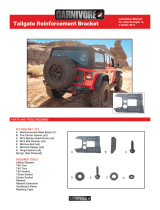 CARNIVORE Spare Tire Reinforcement Bracket Kits Installation guide
CARNIVORE Spare Tire Reinforcement Bracket Kits Installation guide
-
 CARNIVORE Front Bumper & Side Steps Combo Installation guide
CARNIVORE Front Bumper & Side Steps Combo Installation guide
-
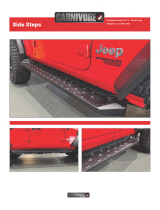 CARNIVORE Side Steps Installation guide
CARNIVORE Side Steps Installation guide
-
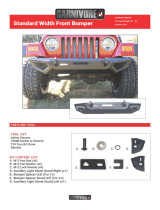 CARNIVORE Front Bumper Installation guide
CARNIVORE Front Bumper Installation guide
-
 CARNIVORE Front Bumper Installation guide
CARNIVORE Front Bumper Installation guide
-
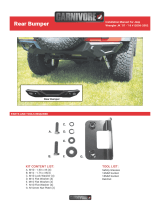 CARNIVORE Front & Rear Bumper Combo Installation guide
CARNIVORE Front & Rear Bumper Combo Installation guide
-
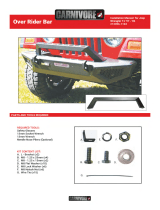 CARNIVORE Over-Rider Bar Installation guide
CARNIVORE Over-Rider Bar Installation guide















